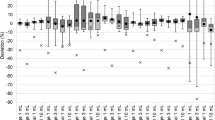Abstract
Introduction
Weight-adjusted dosing is important to maintain accurate quantification for dynamic cardiac three-dimensional positron emission tomography (PET). However, the manufacturer of the only Food and Drug Administration approved rubidium-82 (Rb-82) generator (CardioGen-82, Bracco Diagnostics, Inc.) recommends recalibration after each change in dose which is inefficient in a busy clinical PET lab. The objective of this study was to evaluate the accuracy of Rb-82 dosing without this recalibration.
Methods
After daily calibration to either 30 mCi (1110 MBq) or 12 mCi (444 MBq), Rb-82 doses between 6 and 45 mCi (222-1665 MBq) were eluted and measured on an external dose calibrator. This was repeated for four generators at weeks 1, 2, or 4 of the generator cycle. The measurements were compared with values reported by the infusion system.
Results
For requested doses less than 30 mCi, the measured dose was consistently lower than the requested dose, ranging from −3.2 mCi at 25 mCi to −5.5 mCi at 10 mCi. The error exceeded 10% for doses less than or equal to 26 mCi for the 30 mCi calibration. Residual activity in the infusion system dead volume accounted for the discrepancy between requested and delivered doses for calibration to 30 mCi but not 12 mCi.
Conclusions
The CardioGen-82 infusion system is capable of accurate weight-adjusted doses without recalibration for Rb-82 doses as low as 26 mCi when calibrated to 30 mCi. For doses less than 26 mCi, the generator-reported residual activity within the infusion system can be used to correct the delivered dose.



Similar content being viewed by others
Abbreviations
- PET:
-
Positron emission tomography
- Rb-82:
-
Rubidium-82
- FDA:
-
Food and Drug Administration
References
deKemp RA, Yoshinaga K, Beanlands RSB. Will 3-dimensional PET-CT enable the routine quantification of myocardial blood flow? J Nucl Cardiol. 2007;14:380–97.
Cerqueira MD, Allman KC, Ficaro EP, et al. Recommendations for reducing radiation exposure in myocardial perfusion imaging. J Nucl Cardiol. 2010;17:709–18.
Dorbala S, Blankstein R, Skali H, et al. Approaches to reducing radiation dose from radionuclide myocardial perfusion imaging. J Nucl Med. 2015;56:592–9.
Gerber TC, Carr JJ, Arai AE, et al. Ionizing radiation in cardiac imaging. A science advisory from the American Heart Association Committee on Cardiac Imaging of the Council on Clinical Cardiology and Committee on Cardiovascular Imaging and Intervention of the Council on Cardiovascular Radiology and Intervention. Circulation. 2009;119:1056–65.
Fihn SD, Gardin JM, Abrams J, et al. 2012 ACCF/AHA/ACP/AATS/PCNA/SCAI/STS Guideline for the Diagnosis and Management of Patients With Stable Ischemic Heart Disease. A Report of the American College of Cardiology Foundation/American Heart Association Task Force on Practice Guidelines, and the American College of Physicians, American Association for Thoracic Surgery, Preventive Cardiovascular Nurses Association, Society for Cardiovascular Angiography and Interventions, and Society of Thoracic Surgeons. J Am Coll Cardiol. 2012;60:e44–164.
Fazel R, Gerber TC, Balter S, et al. Approaches to enhancing radiation safety in cardiovascular imaging a scientific statement from the American Heart Association. Circulation. 2014;130:1730–48.
Bracco Diagnostics. CardioGen-82® (Rubidium Rb 82 Generator) Infusion System User Guide. 2013.
Tout D, Tonge C, Muthu S, Arumugam P. Assessment of a protocol for routine simultaneous myocardial blood flow measurement and standard myocardial perfusion imaging with rubidium-82 on a high count rate positron emission tomography system. Nucl Med Commun. 2012;33:1202–11.
Saha GB, Go RT, Macintyre WJ, et al. Use of the 82Sr/82Rb generator in clinical PET studies. Int J Rad Appl Instrum B. 1990;17:763–8.
Gennaro GP, Bergner BC, Haney PS, Kramer RH, Loberg MD. Radioanalysis of 82Rb generator eluates. Int J Rad Appl Instrum. 1987;38:219–25.
Renaud J, Huettges J, Gelbach J, Bush E, Port S, deKemp R. Dynamic range is acceptable for myocardial blood flow quantification with the Scintron LSO 3D-PET system. J Nucl Med. 2015;56:1851.
Klein R, Adler A, Beanlands RS, deKemp RA. Precision-controlled elution of a 82Sr/82Rb generator for cardiac perfusion imaging with positron emission tomography. Phys Med Biol. 2007;52:659–73.
Disclosure
J.B. Moody and B.C. Lee are employees of INVIA. K.M. Hiller has nothing to declare. E.P. Ficaro and J.R. Corbett are stockholders of INVIA, which produces Corridor4DM, a clinical software package for cardiac PET analysis. V.L. Murthy declares research support from INVIA, LLC, and stock interest in General Electric, Mallinckrodt, Cardinal Health.
Author information
Authors and Affiliations
Corresponding author
Electronic Supplementary Material
Below is the link to the electronic supplementary material.
Rights and permissions
About this article
Cite this article
Moody, J.B., Hiller, K.M., Lee, B.C. et al. Limitations of Rb-82 weight-adjusted dosing accuracy at low doses. J. Nucl. Cardiol. 24, 1395–1401 (2017). https://doi.org/10.1007/s12350-016-0531-2
Received:
Accepted:
Published:
Issue Date:
DOI: https://doi.org/10.1007/s12350-016-0531-2




